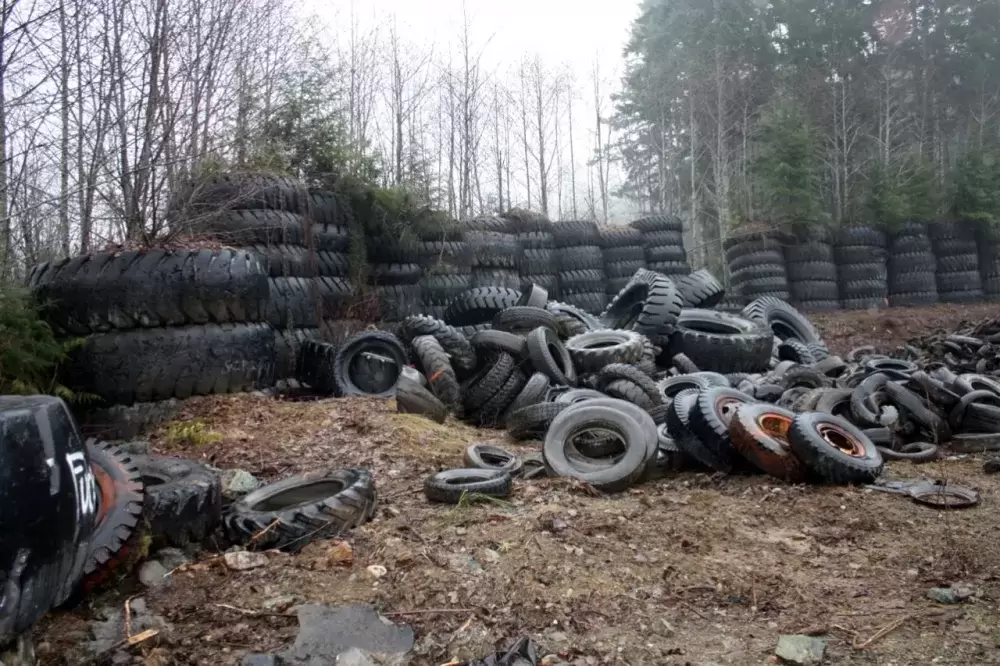A massive abandoned tire dump located less than five kilometres from the Tseshaht reserve is being cleaned up thanks to the efforts of band leadership and the provincial government.
Last August Tseshaht Chief Councillor Hugh Braker led media on a tour of the tire dump which was abandoned by a recycling plant nearly 20 years before, after the business failed. The owners forfeited their damage deposit leaving tens of thousands of tires piled up on about three acres of Crown land.
Myles Mana, director Resource Authorization, Forests Lands and Natural Resource Operations, credits Tseshaht First Nation for getting the ball rolling in the clean-up efforts at the tire dump. He said they got all the right people in one room and things started happening.
In early December, clean-up began. Tires were sorted and recyclables were trucked away to Island Tire Recycling in Chemainus.
The warehouse was completely gutted and more than one ton of trash was removed from the site. The Alberni Clayoquot Regional District waived landfill tipping fees.
Through a partnership formed with Tire Stewardship BC, more than 14 bin trucks full of program tires were removed from the site, an estimated 4,200 tires.
Eight bins of waste wood was removed, chipped and sent to Catalyst Mill.
Two members of Tseshaht First Nation were hired to help in the clean-up operation and local trucking businesses were utilized.
Caring for Crown land is the responsibility of the provincial government, but last summer they deemed clean-up of the tires a low priority. Brennan Clarke, a spokesperson for the Ministry of Forest, Lands and natural Resources Operations, said last summer that water tests from the site showed no evidence of contamination and, although an eyesore, was not high on the priority list of Crown lands that needed to be cleaned up.
“There are lots of sites, Crown land, that have junk on them; issues involving debris on Crown land are addressed by priority, based on resources and available funding. This site is not deemed an immediate priority because it does not pose an immediate environmental threat,” said Clarke.
But Braker wasn’t about to let that position stand.
“In the event of a fire the cost to the province and everyone else would be higher than if they cleaned it up now. Not only would it be difficult to put the fire out, but toxic smoke and fumes would likely settle over the entire Alberni Valley,” he said.
There was clear evidence at that time that the property, with its large, empty building, had been used for recreational purposes. The site was littered with trash, beverage containers and paintballs. Inside the building was a make-shift stage–plywood set atop a pile of tires; and most disturbingly, a fire pit with the remains of charred tire. Tire fires are notoriously difficult to extinguish. Late last year there was a fire in the building that, fortunately, was successfully extinguished.
While a lot of work has been carried out at the site much more needs to be done.
Not all tires will be removed. In fact, the lot was barricaded by a four-meter high berm made of stacked industrial-sized tires. Those tires will remain because they cannot be recycled.
Mana said the plan is to use the wall of tires to protect the site and to aid in sound-deadening from industrial activity in the area.
This has been successfully done in other places in the world, Mana said, adding that the vulcanized rubber is not a danger to the water table and is not a fire hazard if covered with earth and replanted.
A little more than 10 per cent of the tires that were at the site will be used in the berm. Some will form the berm while others will be chipped and used to spread around the lot. About 45cm of earth will be added to cover the chipped tires and then the site will then be planted.
Stewardship BC will pay about $50,000 for the project while the province will pay about $25,000 once all the work is done.
It was a good partnership all the way around,” said Mana.
The project is expected to be complete in late spring when Mana says the land will be in useful condition again.







